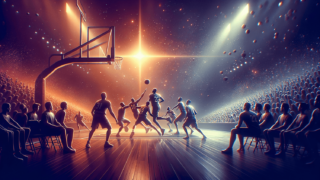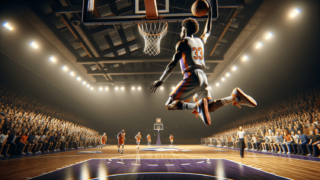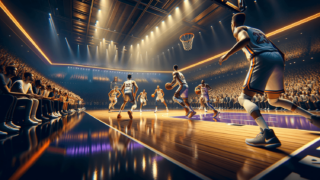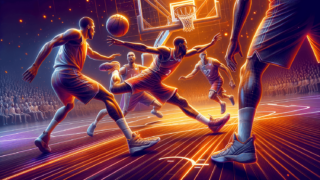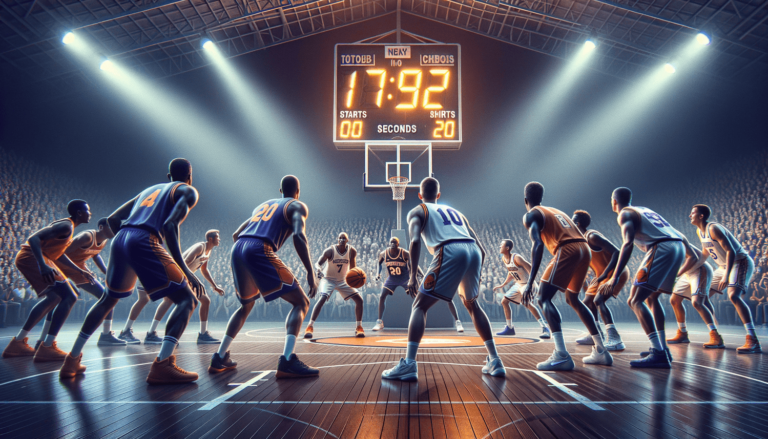
Ten-Second Shot Clock Rule in College Basketball
Written by: Basketball Universe
Last updated:

Get ready to dive into the thrilling world of college basketball with our exploration of the fascinating Ten-Second Shot Clock Rule! 🏀 Oh, sorry no emojis. In this riveting blog post, we’ll unravel the mysteries behind this rule and how it adds intensity and excitement to every game. Whether you’re a seasoned basketball aficionado or a curious newcomer, we guarantee you’ll have a blast discovering how the Ten-Second Shot Clock Rule is enhancing the drama and nail-biting suspense of our beloved sport. So, gear up for a fun and educational journey while we revolutionize your knowledge of this truly captivating game. Swish!
Ten-Second Shot Clock Rule in College Basketball
The Ten-Second Shot Clock Rule in college basketball refers to the maximum time a team has, upon gaining possession of the ball, to advance the ball across the mid-court line, effectively transitioning from defense to offense. If a team fails to cross the mid-court line within ten seconds, they lose possession of the ball, and it is awarded to the opposing team. This rule aims to ensure a faster pace of play, prompting teams to be more strategic and proactive in their offensive approach.
Understanding the Ten-Second Shot Clock Rule
The ten-second rule is an essential part of basketball rules, aimed at making the game more dynamic and encouraging swift transitions between defense and offense. This rule requires teams to cross the mid-court line within ten seconds after gaining possession of the ball. Failure to do so results in a turnover and the opposing team taking possession. The ten-second rule not only adds a challenge to the game, but it also guarantees a more exciting and fast-paced play for spectators.
A Brief History of the Ten-Second Rule
The ten-second rule was first introduced with the aim of establishing a more spectator-friendly and competitive experience. It aimed to reduce long periods of stagnation in the game, where teams would spend significant time in their own half, often dribbling the ball or passing it among themselves. Realizing the importance of creating a balance between offense and defense, the National Collegiate Athletic Association (NCAA) adopted the ten-second rule in 1930.
Implications of the Ten-Second Shot Clock Rule
The ten-second shot clock rule not only impacts the tempo of college basketball games but also influences strategies employed by teams. In this section, we’ll delve into some key aspects of the game that the ten-second rule influences.
Increased Pace of Play
With ten seconds to advance beyond the mid-court line, teams are forced to move quickly and avoid wasting time. This rule mandates speed and agility from players, pushing them to stay constantly on their toes. The result is a more thrilling game that keeps supporters on the edge of their seats and engaged throughout the entire match.
Strategic Adjustments
Teams have had to develop new strategies to adapt to the ten-second rule. Offensive tactics, such as the fast break and quick passes, work to circumvent the requirement of rapid ball advancement. Additionally, defensive tactics have evolved in response, with defenses applying pressure on their opponents across the entire court to force shot clock violations or rushed decisions, leading to turnovers.
Notable Strategies in Response to the Ten-Second Rule
Over the years, coaches have devised various approaches to enhance their team’s capabilities in the face of the ten-second shot clock rule. Let’s take a look at some of these strategies and their impact on the game.
Full-Court Press
Defensive teams, well-aware of the pressure the offense is under to cross the mid-court line in ten seconds, often employ full-court press tactics. This strategy involves extending the defense across the entire court, pressuring the offensive team into making mistakes or committing turnovers. Teams successfully deploying full-court press can wreak havoc on their opponents’ ability to advance the ball within the ten-second window, leading to precious opportunities to regain possession.
Breakaways and Quick Passes
Offensive teams, in turn, have adapted to the ten-second rule with tactics that emphasize speed and agility. Breakaways and quick passes are common methods used to advance the ball swiftly while bypassing defenders. Teams that excel at these tactics often showcase outstanding player coordination and speed, demonstrating exceptional adaptability in high-pressure gameplay situations.
Role of Key Positions in Ten-Second Shot Clock Scenarios
It’s crucial to recognize the significance of specific positions on the court in managing the ten-second shot clock rule. Below, we delve into the roles point guards and forwards play in ensuring the team adheres to the rule.
Point Guards: The Maestros of Ball Handling
Ensuring that your team moves the ball across the mid-court line within ten seconds largely falls on the shoulders of point guards. Often known as the “quarterbacks” of basketball, point guards are primarily responsible for ball handling and initiating the offensive attack. Their role requires proficient dribbling and passing abilities, quick decision-making, and the capacity to analyze the game and respond under immense pressure.
Forwards: Paving the Way
Forwards also contribute to the successful management of the ten-second rule by assisting the point guard in advancing the ball. They often employ screens or well-timed passes to help their team transition seamlessly into offense, utilizing their size and strength to forge a path for their ball-handling teammates. The joint effort of forwards and point guards can make a substantial difference in successfully navigating the critical ten-second shot clock rule.
Learning from the Pros: How the Ten-Second Rule Translates to Professional Basketball
The ten-second rule is not limited to college basketball alone but also holds significance in the professional world. The NBA has a similar rule, albeit with an eight-second shot clock, which elevates the game’s speed and athleticism even further. Let’s explore how the NBA has incorporated the shot clock rule and its impact on the professional stage.
Tracing NBA’s Shot Clock Evolution
The National Basketball Association (NBA) introduced the eight-second shot clock rule in the 2001-2002 season. This adaptation is a testament to how crucial the ten-second shot clock is to the game’s evolution. The NBA sought to make the game even more engaging and fast-paced by further narrowing the window of time within which teams must cross the mid-court line.
Impact on NBA Gameplay
The eight-second shot clock rule has proven to be even more challenging and exhilarating for professional basketball players. As the time requirement is more stringent, both offense and defense levels have soared, as teams need to find new ways to adapt and thrive. Consequently, the eight-second rule has heightened the intensity of NBA games and spawned innovative tactics that continue to reshape how basketball is played on the professional stage.
Preparing for the Ten-Second Shot Clock Rule: How to Train and Succeed
Whether you’re a player, coach, or fan, understanding how to prepare for the ten-second shot clock rule is essential for success in basketball. Here, we cover a range of techniques and methods that can help aspiring players and coaches sharpen their skills and thrive in the face of this crucial college basketball rule.
Drills to Improve Speed and Reaction
Running drills that focus on speed, agility, and reaction time can significantly benefit players under tight time constraints, like the ten-second rule. Some essential drills to consider include:
- Suicides: Also known as lines or sprint drills, suicides help develop players’ responsiveness and cardiovascular fitness, enabling them to maintain a rapid pace throughout the game.
- Two-ball dribbling: These drills, which require players to dribble two balls simultaneously, are particularly useful for point guards looking to hone their ball-handling skills under pressure.
- Mirror drills: Players can improve their defensive skills and agility by mimicking a teammate’s movements in one-on-one mirror drills. These exercises require rapid response and adjustments, simulating the intense tempo of game situations.
Adopting a Team Mentality
Thriving under the constraints of the ten-second shot clock rule necessitates strong team dynamics, where each player’s success is reliant on the support of their teammates. Building trust and mutual understanding between players can enhance the team’s ability to navigate the challenges imposed by the rule. A cohesive team is well-placed to effectively execute offensive and defensive strategies, optimizing their chance for success on the court.
Wrapping Up
The ten-second shot clock rule is a vital element in the world of college basketball. Its influence extends to strategies, player roles, and even professional basketball. Inculcating an understanding of the rule and honing essential skills can set basketball enthusiasts on the road to success. Remember, it’s all about getting into the rhythm of the sport and enjoying the thrill that this fast-paced game has to offer.
Notable Games Impacted by the Ten-Second Rule
Throughout the history of college basketball, there have been numerous instances when the ten-second shot clock rule played a significant role in determining the outcome of games. Let’s delve into some unforgettable moments where this rule made a crucial difference.
2016 NCAA Tournament: Northern Iowa vs. Texas A&M
In this remarkable game, Northern Iowa had a 12-point lead with just 44 seconds left in regulation. However, Texas A&M staged a furious comeback, capitalizing on a series of ten-second shot clock violations by Northern Iowa. Texas A&M tied the game, forcing it into overtime, and eventually secured a victory. This game serves as a prime example of how the ten-second rule can create nail-biting climactic moments in college basketball.
2019 NCAA Tournament: Duke vs. Louisville
In another thrilling matchup, Louisville held a commanding lead over Duke, with just over nine minutes left in the second half. Duke, however, turned the tide by aggressively applying defensive pressure, causing multiple ten-second shot clock violations by Louisville. The momentum shifted and Duke ultimately won the game. The ten-second rule played a pivotal role in the game’s outcome, demonstrating how defensive strategies revolving around this rule can steer the course of a match.
Drills to Improve Ten-Second Rule Adherence
Developing the ability to consistently adhere to the ten-second shot clock rule requires consistent practice and well-structured drills. Here are some useful drills that coaches and players can use to improve their skill set and acclimate to the demands of the ten-second rule:
Alternating Full-Court Press and Fast-Break Drills
Divide your team into two groups, designating one group on offense and the other on defense. Alternating offensive and defensive roles, simulate a full-court press by the defensive group, while the offensive group practices breaking the press and advancing the ball across the mid-court line. Turnovers resulting from the ten-second rule or intercepted passes inform where improvements need to be made.
Timed Shuttle Relays with Passes
This drill focuses on advancing the ball up the court using a series of rapid passes between teammates. With the clock set for ten seconds, players must complete a shuttle relay and advance the ball from one baseline to the other before the time runs out. By incorporating different passing techniques, players can develop a vast repertoire of effective offensive strategies for overcoming the ten-second shot clock rule.
Fun Facts about the Ten-Second Rule
To wrap up our discussion on the ten-second shot clock rule, let’s explore some interesting trivia that might pique your curiosity even further:
- The very first ten-second rule in basketball was established in 1933, although it was instituted only in the last three minutes of the game.
- Before enforcing the ten-second rule, referees employed a “slow whistle” technique, which required them to control the pace of the game by penalizing teams that took too long to advance the ball.
- Historically, the ten-second rule was not in play during jump-ball situations. However, this changed in the 1937-38 season when a new rule mandated that teams had ten seconds to inbound the ball and attempt a shot following a jump-ball.
Frequently Asked Questions about the Ten-Second Shot Clock Rule
In this section, we address some commonly asked questions about the Ten-Second Shot Clock Rule in college basketball to help deepen your understanding of how this rule influences gameplay, strategies, and skill development.
1. Why was the ten-second shot clock rule implemented?
The ten-second shot clock rule was implemented in college basketball to increase the game’s tempo, reduce stagnation, and enhance the overall competitive spirit of matches by forcing teams to be proactive in their offensive approach.
2. When was the ten-second shot clock rule introduced?
The National Collegiate Athletic Association (NCAA) introduced the ten-second shot clock rule in 1930 to make college basketball games more competitive and engaging for both players and spectators.
3. Does the ten-second rule apply to professional basketball as well?
Yes, the NBA also enforces a shot clock rule similar to College basketball’s ten-second rule, but with a shorter eight-second window to cross the mid-court line to create an even faster-paced game experience for professional players and fans.
4. Are there any differences in enforcement of the ten-second shot clock rule between men’s and women’s basketball?
No, there is no difference in enforcement of the ten-second shot clock rule between men’s and women’s basketball in the NCAA, ensuring that both categories of games are equally engaging and competitive.
5. How do teams counteract opponents’ full-court press strategies?
Offensive teams typically counteract a full-court press defense by employing quick passes, breakaways, and screens to advance the ball across the mid-court line within the ten-second window and effectively transition to offense.
6. What happens if a team fails to advance the ball past the mid-court line within ten seconds?
If a team fails to pass the mid-court line within ten seconds of possessing the ball, it results in a turnover, and the opposing team gets possession. The rule ensures that teams are always making fast and strategic offensive plays.
7. Can the defense steal the ball from their opponents during these ten seconds?
Yes, the defensive team can attempt to steal the ball from their opponents within the ten-second timeframe. If successful, it often leads to fast breaks and scoring opportunities for the defense-turned-offense.
8. How does the ten-second rule affect point guards differently from other players?
Point guards bear primary responsibility for ball handling, initiating the offense, and advancing the ball across the mid-court line. Consequently, the ten-second rule has a more significant impact on point guards, requiring them to excel in dribbling, passing, decision-making, and pressure management.
9. How does the ten-second rule influence defensive strategies in college basketball?
The ten-second rule impacts defensive tactics by encouraging teams to apply pressure on their opponents throughout the entire court, forcing shot clock violations or rushed decisions that lead to turnovers or low-percentage shots.
10. What drills are helpful for players to better adapt to the ten-second rule?
Effective drills for improving a team’s ability to handle the ten-second shot clock rule include suicide drills for speed and agility, two-ball dribbling drills for enhanced ball-handling skills, mirror drills for defensive reflexes, full-court press and fast-break simulations, and timed shuttle relays with passes for rapid offensive advancement.
Featured Posts
- No pillar pages found.

